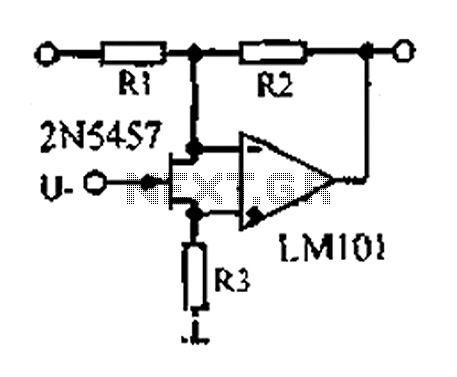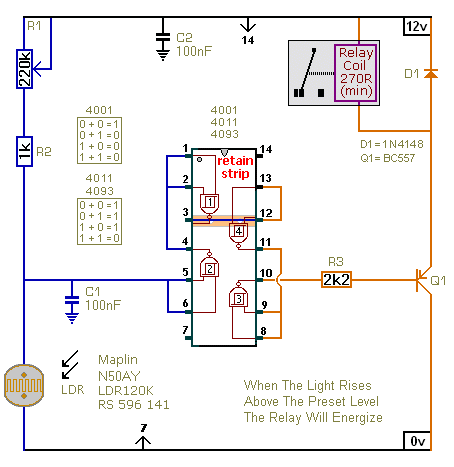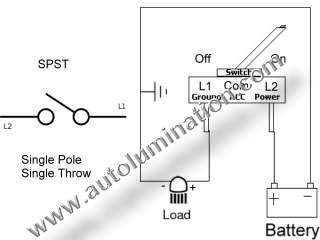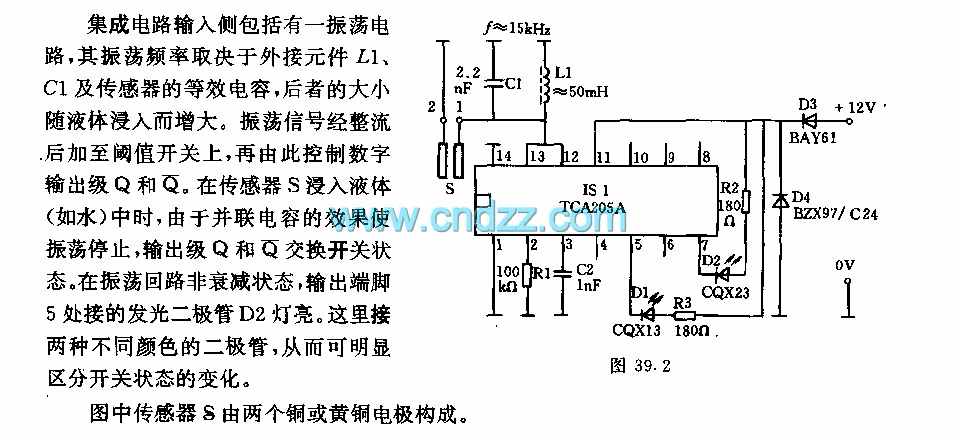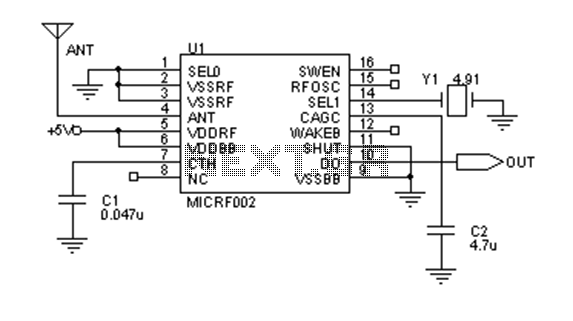
ir remote controlled switchboard rc5
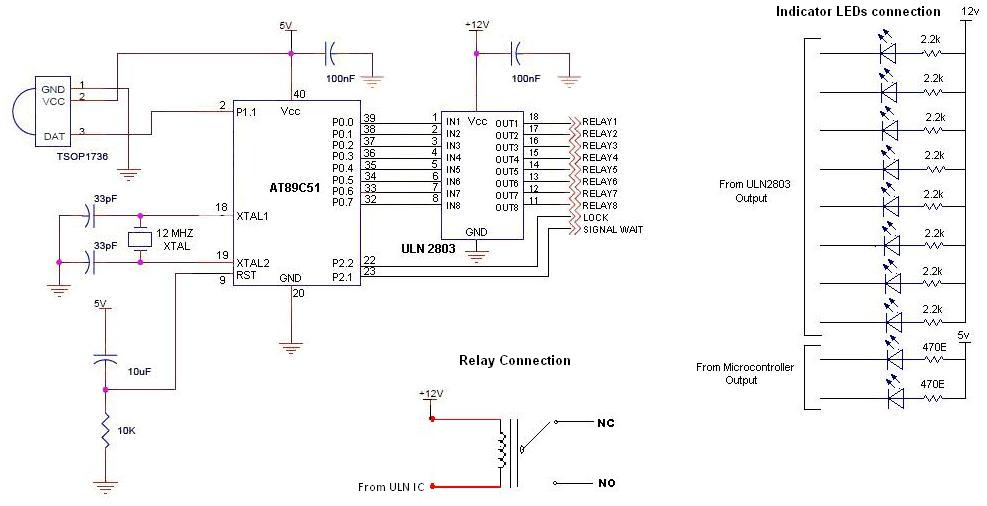
To control multiple switches, it is necessary to transmit several bits via infrared (IR) transmission to indicate which key is pressed on the remote control and, consequently, which switch on the switchboard to operate. This project utilizes a commercially available IR remote control that operates on the RC5 protocol, developed by Philips for managing consumer electronics such as televisions and VCD/DVD players. This type of remote control is commonly found in Philips' 90-channel televisions. The RC5 protocol is widely recognized and straightforward to comprehend. Essentially, when a key on the remote controller is pressed, a total of 14 bits are transmitted serially. This transmission includes 2 start bits, 1 toggle bit, 5 address bits, and 6 data bits. These 14 bits are sent over a carrier frequency of 38/36 kHz using Manchester coding, with high and low times of 889 microseconds. At the receiving end, a TSOP1738 receiver is employed to demodulate the carrier signal and output serial data. This serial data is processed by an AT89C51 microcontroller, which decodes the transmitted data and controls the output accordingly. Relays are used for the switching action and are driven by the microcontroller through a ULN2803 integrated circuit. The circuit diagram is provided below.
To implement this circuit effectively, the following components and connections are essential:
1. **IR Remote Control**: The remote control must be compatible with the RC5 protocol, ensuring that it can send the necessary 14-bit data when a button is pressed.
2. **TSOP1738 IR Receiver**: This component receives the modulated IR signal from the remote control. It is critical for converting the IR light signal into an electrical signal that can be processed by the microcontroller. The TSOP1738 is designed to demodulate signals at the specified carrier frequency of 36-38 kHz.
3. **AT89C51 Microcontroller**: This microcontroller is responsible for decoding the received serial data. The microcontroller should be programmed to interpret the 14-bit data format, extracting the address and data bits to determine which switch to activate.
4. **ULN2803 Driver IC**: This is a high-voltage, high-current Darlington transistor array used to drive the relays. It allows the microcontroller to control multiple relays without exceeding its output current limitations.
5. **Relays**: The relays serve as the switching elements that control the actual load or switchboard. Each relay corresponds to a particular switch, and the microcontroller activates the appropriate relay based on the decoded data.
6. **Power Supply**: Ensure that all components are powered adequately. The microcontroller and receiver typically operate at 5V, while the relays may require a higher voltage depending on their specifications.
7. **Circuit Connections**:
- Connect the output of the TSOP1738 to one of the input pins of the AT89C51.
- Program the microcontroller to read the incoming data and determine which relay to activate.
- Connect the outputs of the AT89C51 to the input pins of the ULN2803.
- Connect the outputs of the ULN2803 to the relays, ensuring that the relays are connected to the appropriate load or switchboard.
This schematic design allows for effective control of multiple switches using a simple IR remote control, leveraging the well-established RC5 protocol for reliable communication.As more than one switches are to be controlled, we have to transmit a number of bits through IR transmission to indicate which is key is pressed on the remote and accordingly which switch of the switch-board to control. In this project, this is done by using a ready-made IR remote control which works on RC5 protocol. RC5 protocol was developed by Phillips for controlling consumer electronics such as TV, VCD-DVD Player, etc. through IR Remote Controller. This type remote controller can be found in Phillips` 90 channel TVs. This is a very popular IR protocol and very easy to understand. Basically, in a RC5 protocol, when a key on the remote controller is pressed, a total of 14 bits are serially transmitted. This includes 2 Start bits, 1 Toggle bit, 5 Address bit and 6 Data bit. These 14 bits are transmitted on a carrier of 38/36 khz carrier by using Manchester Coding. High and Low time are 889 us. For more on Manchester Coding and RC5 protocol, read this. At the receiver, TSOP1738 receiver is used. It removes the carrier and provides serial data. This serial data is applied to AT89C51 microcontroller for decoding serially transmitted data and control the output accordingly.
Relays are used for switching action and they are controlled by the microcontroller through the ULN2803 IC. Circuit diagram is shown below : 🔗 External reference
To implement this circuit effectively, the following components and connections are essential:
1. **IR Remote Control**: The remote control must be compatible with the RC5 protocol, ensuring that it can send the necessary 14-bit data when a button is pressed.
2. **TSOP1738 IR Receiver**: This component receives the modulated IR signal from the remote control. It is critical for converting the IR light signal into an electrical signal that can be processed by the microcontroller. The TSOP1738 is designed to demodulate signals at the specified carrier frequency of 36-38 kHz.
3. **AT89C51 Microcontroller**: This microcontroller is responsible for decoding the received serial data. The microcontroller should be programmed to interpret the 14-bit data format, extracting the address and data bits to determine which switch to activate.
4. **ULN2803 Driver IC**: This is a high-voltage, high-current Darlington transistor array used to drive the relays. It allows the microcontroller to control multiple relays without exceeding its output current limitations.
5. **Relays**: The relays serve as the switching elements that control the actual load or switchboard. Each relay corresponds to a particular switch, and the microcontroller activates the appropriate relay based on the decoded data.
6. **Power Supply**: Ensure that all components are powered adequately. The microcontroller and receiver typically operate at 5V, while the relays may require a higher voltage depending on their specifications.
7. **Circuit Connections**:
- Connect the output of the TSOP1738 to one of the input pins of the AT89C51.
- Program the microcontroller to read the incoming data and determine which relay to activate.
- Connect the outputs of the AT89C51 to the input pins of the ULN2803.
- Connect the outputs of the ULN2803 to the relays, ensuring that the relays are connected to the appropriate load or switchboard.
This schematic design allows for effective control of multiple switches using a simple IR remote control, leveraging the well-established RC5 protocol for reliable communication.As more than one switches are to be controlled, we have to transmit a number of bits through IR transmission to indicate which is key is pressed on the remote and accordingly which switch of the switch-board to control. In this project, this is done by using a ready-made IR remote control which works on RC5 protocol. RC5 protocol was developed by Phillips for controlling consumer electronics such as TV, VCD-DVD Player, etc. through IR Remote Controller. This type remote controller can be found in Phillips` 90 channel TVs. This is a very popular IR protocol and very easy to understand. Basically, in a RC5 protocol, when a key on the remote controller is pressed, a total of 14 bits are serially transmitted. This includes 2 Start bits, 1 Toggle bit, 5 Address bit and 6 Data bit. These 14 bits are transmitted on a carrier of 38/36 khz carrier by using Manchester Coding. High and Low time are 889 us. For more on Manchester Coding and RC5 protocol, read this. At the receiver, TSOP1738 receiver is used. It removes the carrier and provides serial data. This serial data is applied to AT89C51 microcontroller for decoding serially transmitted data and control the output accordingly.
Relays are used for switching action and they are controlled by the microcontroller through the ULN2803 IC. Circuit diagram is shown below : 🔗 External reference
Warning: include(partials/cookie-banner.php): Failed to open stream: Permission denied in /var/www/html/nextgr/view-circuit.php on line 713
Warning: include(): Failed opening 'partials/cookie-banner.php' for inclusion (include_path='.:/usr/share/php') in /var/www/html/nextgr/view-circuit.php on line 713
